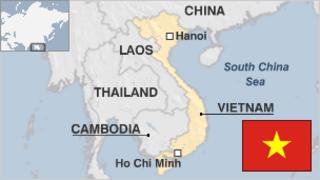Vietnam country profile
Vietnam, a one-party Communist state, has one of south-east Asia’s fastest-growing economies and has set its sights on becoming a developed nation by 2020.
It became a unified country once more in 1975 when the armed forces of the Communist north seized the south.
This followed three decades of bitter wars, in which the Communists fought first against the colonial power France, then against South Vietnam and its US backers. In its latter stages, the conflict held the attention of the world.
The US joined the hostilities in order to stem the “domino effect” of successive countries falling to Communism.
FACTS
Socialist Republic of Vietnam
Capital: Hanoi
Population 92 million
Area 329,247 sq km (127,123 sq miles)
Major language Vietnamese
Major religion Buddhism
Life expectancy 73 years (men), 81 years (women)
Currency dong
LEADERS
President: Nguyen Phu Trong
Nguyen Phu Trong was appointed to the largely ceremonial post of president by parliament in October 2018, a few weeks after President Tran Dai Quang died in officeHe also holds the much more powerful post of secretary-general of the ruling Communist Party, which he assumed in January 2011.
Prime minister: Nguyen Xuan Phuc
Nguyen Xuan Phuc was elected to the post of prime minister by parliament in April 2016, after being picked to succeed outgoing leader Nguyen Tan Dung at the Communist Party’s congress in January.
Mr Phuc, 61, pledged to improve the business climate and crack down on corruption.
Unlike his charismatic predecessor, he is seen as a team player and a technocrat ready to stick to the party line.
MEDIA
The Communist Party has a strong grip on the media.
Media outlets and journalists risk sanctions for broaching sensitive topics and for criticising the government. But some press titles and online outlets do report on corruption in official circles.
There were 64 million internet users by the end of 2017, comprising around 66% of the population (Internetworldstats.com).
TIMELINE
1859-83 – France slowly colonises Indochina.
1940 – Japan takes control of Indochina.
1945 – Ho Chi Minh proclaims independence and establishes the Democratic Republic of Vietnam.
1946 – French seek to regain control. Anti-French resistance war – or the First Indochina War – spreads across country.
1954 – Vietnam is partitioned between North and South. Conflict between the two rival states rages for the next two decades, in what is known as the Vietnam War or the Second Indochina War. The US is heavily involved in support of the South.
1975 – Southern cities fall one by one until communist forces seize Saigon.
1976 – Vietnam is reunified as the Socialist Republic of Vietnam. Hundreds of thousands flee abroad, including many “boat people”.
1979 – Vietnam invades Cambodia and ousts the Khmer Rouge regime of Pol Pot.
Source: Read Full Article



